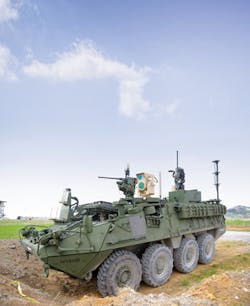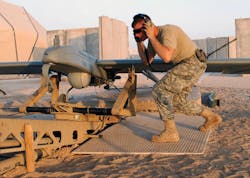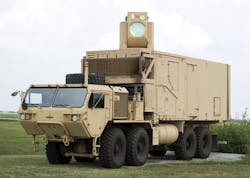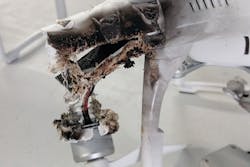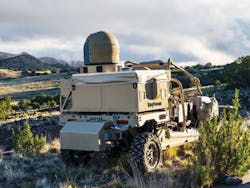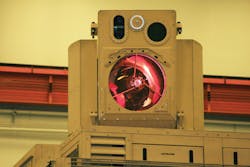The new world of counter-drone technology
Attempts to prevent unmanned aerial vehicles (UAVs) from surveillance, terrorist, or military attacks involve methods ranging from electronic jamming, to nets, to bullets, and even to birds of prey. By J.R. Wilson
Only a little more than a quarter century ago, unmanned aerial vehicles (UAVs) largely were just a curiosity, with little support from the operational military. That began to change with the First Gulf War in 1991 and the successful use of the Pioneer UAV, which by today’s standards, was a primitive and limited-use surveillance aircraft. The need to defend against UAVs rarely was even a consideration.
With the Second Gulf War a decade later, UAVs came into their own. Today, they are an essential part of U.S. military missions and operations and are in high demand by nearly every military and law-enforcement agency on the planet. Unlike most critical military equipment, however, UAVs also have gone commercial, equally sought by everyone from oil companies to ranchers, to news media outlets, to environmentalists, forestry services, and fish and wildlife observers.
Darker forces are at work, too. UAVs also are on the shopping lists of criminals ranging from drug cartels, to human smugglers, to corporate spies.
As UAVs have become increasingly popular across many different user communities, their prices have dropped from government-budget levels to less than that of a TV set. What the government developed in sensor and weapons payloads also has moved into those user groups, albeit not as sophisticated or, in the case of weapons, massively lethal. UAVs now are considered a top threat posed by terrorists, criminals, fanatics, and others who never before had such a versatile, stealthy, and cheap airborne weapon.
This has made counter-UAV technologies and systems a top — and increasingly classified — priority for the military, Department of Homeland Security, major law enforcement agencies, and the contractors producing them. Seeking to maintain a time and technology advantage over threat users, those groups essentially have stopped making public statements about C-UAV.
This new topic of C-UAV is divided into two primary areas: detection and tracking systems; and interdiction. The former includes radar, radio frequency (RF), electro-optical (EO), infrared (IR), acoustic, and combined sensors. Interdiction includes jamming RF and GNSS (Global Navigation Satellite System, which includes GPS and GLONASS), spoofing, lasers, physical nets to entangle the target, projectiles, electromagnetic pulse (EMP), water projectors, “suicide” drones, and combinations of those.
No perfect solutions
There are no perfect detection methods. Many affordable electro-optical sensors are limited to daylight operations and a direct line-of-sight to the target (also true for IR and many RF systems). RF and acoustic sensors use a library of known sounds and frequencies to detect UAVs, but the rapid development of new platforms makes it impossible for those to be fully up-to-date. Sensor sensitivity also is an issue; too sensitive generates many false positives, while reduced sensitivity leads to false negatives.
C-UAV systems, employing combined data from several sensors, also must be able to differentiate between legitimate and hostile, allied, and enemy UAVs — something no known system can do. This is where a human operator must intervene to make what often is a split-second assessment. Interdiction methods also all have potentially negative outcomes, from being blocked by electronic warfare countermeasures to falling onto civilian or friendly forces.
Decades ago saw a flurry of activity in developing unmanned aircraft. Today just as much effort is going into new ways to counter UAVs.
“Compounding the effectiveness issue is the fact that drone technology itself is not standing still,” according to a February 2018 Counter-Drone Systems report from The Center for the Study of the Drone at Bard College in Annandale-on-Hudson, N.Y. “The C-UAS market will therefore have to constantly respond to new advances in unmanned aircraft technology. As the unmanned aircraft systems market expands, counter-drone systems will need to be flexible enough to detect and neutralize a growing variety of targets, ranging from large unmanned aircraft capable of carrying heavy payloads through to low-flying micro surveillance drones that might only weigh a few grams.”
Sometimes UAV technologies evolve so quickly that counter-UAV systems just can’t keep up. “The proliferation of C-UAS technology might even accelerate the development of technologies that will render C-UAS systems ineffective, particularly in military environments,” the article continues. “Drones might be programmed to operate in patterns that make them difficult to detect, or rotors might be modified to dampen a drone’s engine noise so that it can evade acoustic detection. Drones might be designed in such a way as to reduce their radar signature. Counter-laser systems could protect drones from directed-energy attacks. Finally, forces might seek to deploy drone swarms, which present a range of vexing technical challenges from a C-UAS perspective.”
Ground- or air-based
C-UAV systems can be ground- or air-based or even handheld. Most systems on the market today are designed only for detection or for interdiction and the clear majority are ground-based, although a few comprise air and ground components.
One impetus for this reclassification of information about counter-UAV technologies and missions can be seen in FBI Director Christopher Wray’s October comments about the “steadily escalating threat” of UAVs by terrorists and criminal organizations at a hearing of the Senate Homeland Security and Governmental Affairs Committee.
The Boeing laser on a heavy truck called the High Energy Laser Mobile Demonstrator.
“While there has been no successful malicious use of UAS [unmanned aerial systems] by terrorists in the United States to date, terrorist groups could easily export their battlefield experiences to use weaponized UAS outside the conflict zone,” he told lawmakers in written testimony.
“The FBI assesses that, given their retail availability, lack of verified identification requirement to procure, general ease of use and prior use overseas, UAS will be used to facilitate an attack in the United States against a vulnerable target, such as a mass gathering.”
The UAVs available to and used by such groups are several generations behind the most advanced U.S. military platforms. Still, their payload capacity, guidance and navigation, and range are adequate for smuggling drugs, surveilling routes for human traffickers, or even attacking critical infrastructure or mass public gatherings like sporting events or concerts.
The threat of such applications grows almost exponentially with each new development in commercial UAVs or those developed by and for foreign militaries that find their way onto the black market. It is unlikely that terrorists or criminal organizations ever will be able to match UAVs in U.S. and allied inventories, but such parity is not necessary for their applications.
The counter-UAV mission relies heavily on advanced sensors; long-endurance platforms; data fusion to provide a view of the airspace being guarded; and some form of artificial intelligence (AI) to sort through and analyze incoming data. This process is far more attractive than sending raw UAV sensor data to a human operator.
Leonardo DRS is developing the vehicle-mounted Mobile Low, Slow Unmanned Aerial Vehicle Integrated Defense Systems (MLIDS) to disable small drones.
C-UAV can be airborne, fixed or mobile ground-based or even sea-based. For example, a high-speed mobile battlefield C-UAV system — the eXpeditionary Mobile Aerial Defense Integrated System (X-MADIS) — is being developed by Sierra Nevada Corp. in Sparks, Nev.; Ascent Vision Technologies LLC in Belgrade, Mont.; and RADA Electronic Industries Ltd. in Netanya, Israel.
X-MADIS is capable of long-range UAV detection, identification, and defeat while traversing rough terrain at speeds to 30 miles per hour. According to Sierra Nevada, the C-UAV, radar and electro-optical/infrared (EO/IR) equipment are integrated onto a commercial off-road vehicle to detect, locate, identify, track, exploit, and defeat hostile UAVs threatening airports, critical infrastructure, or entering no-fly zones.
Enhanced counter-UAV sensors
Sensors also have been advancing rapidly in sensitivity, range, and reduced size and power requirements. Combined with high-speed wireless networking, onboard data fusion, and AI, they have significantly increased the capabilities of C-UAV systems.
“Our security mission is architected around multiple sensors to give the best picture of the airspace and lowest false alarm rate, looking for anything moving in the airspace,” says Craig Marcinkowski, director of the SRC Inc. Gryphon Sensors business unit in North Syracuse, N.Y. “But a large bird and small drone could look the same on radar, so you also look for communications links, at which point you may have a camera that slews over to get a better look.
“Today, there is an operator in the loop at some level, assessing what is on the screen, what kind of payload a drone may be carrying,” Marcinkowski continues. “We’re working on automatic image lookup, where you can take the operator out of the loop to identify a bird from a drone. We’re focused on deconflicting the low-altitude airspace and safe airspace integration, enabling beyond visual line-of-sight flying, using sensors that create an accurate 3D image of what’s out there. You also can use that data for security applications around critical infrastructure.”
One of the drones shot down by a MEHEL-equipped Stryker in April at Fort Sill during MFIX-17. Lessons learned during MFIX-17 will make the MEHEL easier for Soldiers to operate.
Military challenges
The other side of counter-UAV is more complex — military programs to counter enemy UAVs, ranging from those performing intelligence, surveillance and reconnaissance (ISR) missions against U.S. or allied forces to stopping hunter-killer UAVs sent to attack such forces or cripple critical infrastructure.
While the current adversaries engaging U.S. forces are terrorist, insurgent, or would-be states (i.e., the Taliban and ISIS), whose UAVs are similar to those being confronted along U.S. borders and coastal areas. Future conflicts may see the U.S. facing something it has not seen in the air for decades — peer or near-peer technologies and capabilities.
“Enemy unmanned aircraft are among the biggest threats facing our ground troops today,” Thomas Bussing, vice president of the Raytheon Co. Advanced Missile Systems segment in Tucson, Ariz., said in July while announcing a contract from the Army to use Raytheon’s small, expendable Coyote UAV and KRFS radar to combat enemy UAVs in the battlespace.
The Army already has tested an anti-UAV defense system (AUDS) during the 2017 Maneuver Fires Integrated Experiment at Fort Sill, Okla. AUDS comprises two 180-degree radars mounted back-to-back to provide 360-degree real-time coverage and a camera to confirm the target’s identity. Once confirmed as a hostile UAV, the operators can destroy it, or jam its communications, causing the UAV to return home or crash.
Dr. Robert W. Sadowski, the U.S. Army’s Chief Roboticist at the Tank Automotive Research, Development and Engineering Center (TARDEC) in Warren, Mich., says the military also is adapting and improving commercial developments to meet that threat.
“Commercial is more leveraging technologies that have been hardened for military applications,” Sadowski says. “The range of temperatures they operate under is a little more relaxed, so that has to be ruggedized. The commercial world has been really pushing down the cost of sensors, which also are getting smaller, enabling more sensors to be placed on existing UAVs.
Raytheon’s Multispectral Targeting System (MTS) combines optical and infrared sensors to acquire and track airborne targets and direct the laser beam it fires. For C-UAV, the MTS was modified to track Class-1 drones (under 20 pounds) and Class 2 drones (between 20 and 55 pounds), the most common sizes used by terrorists and insurgents.
Sensor fusion
“Sensor fusion is another area where a lot of work is being done on multi-modal radars and camera imagery,” Sadowski continues. “The other piece, the auto industry, brings in high computing capability for low cost and power. Where a decade ago you might have needed a supercomputer, today the gaming industry has helped bring the cost and size of high-performance computing down.”
In July, the Army announced a $13 million award to Leonardo DRS to continue engineering and testing of the Mobile Low, Slow UAV Integrated Defense System (MLIDS). In October 2017, the company was awarded a $43 million production contract for an undisclosed number of MLIDS to meet the Army’s need to counter small, inexpensive UAVs — such as commercial quadcopters — operating as airborne improvised explosive devices (IEDs).
MLIDS is mounted on two mine-resistant, ambush-protected all-terrain vehicles (M-ATVs), one carrying the DRS elevated mast-mounted surveillance and battlefield reconnaissance equipment (EO/IR sensors), the other a reconfigurable integrated-weapons platform (RIwP) developed by Leonardo and Moog, capable of firing a range of kinetic weapons, and a small UAV.
“Drones are becoming an increasingly dangerous threat against our forward-deployed soldiers and we are proud to support this urgent requirement to protect them from potentially lethal small unmanned aerial vehicles,” Aaron Hankins, vice president and general manager for DRS Land Systems, said at the time. “We are working hard to deliver the best capability to our soldiers as quickly as possible.”
Military C-UAV systems rely on multi-layered detection technologies — EO/IR, RF scanners, radar. cameras, jammers and tracking software. They also can include a variety of kill capabilities, from guns and rockets to lasers and electronic warfare (EW).
Market analysts predict the global military market for C-UAV will grow from around $300 million today — primarily U.S. research, development, testing and evaluation (RDT&E) — to around $1 billion by the end of 2019. The commercial market has tripled in the past year, from around $30 million to close to $100 million, although that is predicted to be limited by FAA regulations on UAV flight in the national airspace and a lack of proven UAV attacks — including corporate espionage — on U.S. targets.
The Boeing High Energy Laser Mobile Demonstrator (HEL MD), developed originally to protect forward-deployed warfighters from rockets, mortars, and artillery shells, is yielding laser weapons technology to counter unmanned aerial vehicles.
The role of artificial intelligence
AI is even more important to the future of military counter-UAV than it is to border protection.
“[The key is] how to do real-time processing of video feeds and create effective perception in a complex electromagnetic environment, synthesized so the commander can make decisions quickly,” says TARDEC’s Sadowski. “How do we do reasoning at the tactical level, making the mechanical platform part of the team? There is a lot of work that needs to be done on human/machine interface and cognitive load. These are things under active pursuit in the labs now, how to do real-time updates, advanced situational awareness and solving the perception and prediction problems.
“Most of what we’re working on now is more deterministic systems,” Sadowski continues. “AI is less deterministic. You have to train the robot to do what it needs to do. That requires lots of training runs with relevant data, but some amazing things are being done in that space. Start off with perception — is that a bird, a balloon or a UAV; then prediction, taking stuff between frames and stitching together a temporal message, which leads to planning. Prediction has not yet been done by neural nets. Some of these things can be solved working with machine learning or AI.”
As with any military capability, advances by one side are quickly challenged by advances on the other side. Rapid technological advances being made on an almost daily basis by commercial and military scientists and engineers have put additional pressures on the development and fielding of UAVs and counter-UAV systems.
“AI is a really key area. China is making a strong push in AI, which is a serious concern. The U.S. is still in the lead, but China has made this a national priority, with large investments and a huge focus, “says Phil Finnigan, UAV analyst at the Teal Group market research firm in Fairfax, Va.
“Another revolutionary technology is low-cost HALE [high altitude, long endurance]. Some of the systems primarily being developed for the civil/commercial world, primarily by Airbus and AeroVironment, for example, offer tremendous potential for long-term surveillance or communications at low cost. That is being driven by commercial programs, but will have a lot of defense and homeland security applications.”
A HALE UAV offers wider coverage for an extended time during ISR missions, giving military and homeland security users a greater chance of detecting and identifying hostile UAVs, sending back information in real-time to enable the employment of appropriate counter-UAV measures. Those range from guns and rockets to non-kinetic electronic signals to jam, spoof, destroy, or take over the target UAV’s navigation and control systems. One option under investigation, for example, would cause the UAV to return to its launch point, enabling authorities to locate and take appropriate action against adversary ground-control stations and personnel.
Cyber security
In a mirroring of the long-standing armor/anti-armor development cycle, some companies have begun working on counter-C-UAV, such as Raytheon’s Electronic Armor to prevent UAVs from being hacked.
UAVs have demonstrated their value during the wars in Iraq, Afghanistan and Syria. First used by the U.S., then its allies, they now are a common weapon of ISIS and other non-state groups, primarily as flying IEDs.
Today, UAVs come in all types, sizes and prices, with hundreds of manufacturers in most of the world’s nations. That, in turn, has spurred an explosion in the number of C-UAV manufacturers and systems in just the past year or two and the start of yet another layer with counter-C-UAV.
Among those who have announced or demonstrated programs are: Advanced Ballistics Concepts, Aaronia AG, Accipter, Advanced Protection Systems, Airbus DS Electronics, Airspace Systems, Alion Science & Technology, Allen-Vanguard, ApolloShield, BAE Systems, Batelle, BATS, Blighter Surveillance, Boeing, CACI, Chenega Europe, Cintel, Citadel Defense, CTS Technology, Dedrone, Delft Dynamics, Department 13 Intl., DeTect, DJI, Drone Defence, DroneShield, DRS/Moog, Dubai Civil Aviation Authority, General Dynamics, Groupe Assman, Gryphon Sensors, Guard From Above, Hensoldt, IACIT, Kalashnikov/ZALA Aero Group, KB Radar Design Bureau, L3 Technologies, Liteye Systems, Lockheed Martin, Malou Tech, MBDA Deutschland, Meritis, MCTech, Northrop Grumman, OpenWorks Engineering, Prime Consulting & Technologies, Rafael, Raytheon, Saab, Sanad Academy, Securus Technologies, Sensofusion, Sierra Nevada, Skysec, Snake River Shooting Projects, SRC, Systems DroneShield, SystemsGrok, Thales, Theiss UAV Solutions, UMS Aero Group.
According to the Counter-Drone Systems report, 155 companies in more than 30 nations were working on more than 230 C-UAV products; all three numbers almost certainly have grown since then. Those do not include military labs such as DARPA, the Russian Foundation for Advanced Research Projects and China’s Scientific Research Steering Committee.
Counter-drone company list
Aaronia AG
Strickscheid, Germany
https://www.aaronia.com
Accipiter Radar Corp.
Orchard Park, N.Y.
https://www.accipiterradar.com
Advanced Protection Systems LLC
Rutherford, N.J.
http://apsystems.tech/en/
Airspace Systems Inc.
San Leandro, Calif.
https://airspace.co
Alion Science & Technology Corp.
McLean, Va.
https://www.alionscience.com
Allen-Vanguard Corp.
Ottawa
http://www.allenvanguard.com
ApolloShield
Palo Alto, Calif.
https://www.apolloshield.com
Batelle
Columbus, Ohio
https://www.battelle.org
Blighter Surveillance Systems
Great Chesterford, England
http://www.blighter.com
Chenega Europe
Belfast, Norther Ireland
http://www.chenegaeurope.com
CINTEL LLC
Peachtree City, Ga.
http://cintelusa.com
Citadel Defense Co.
San Diego
https://www.dronecitadel.com
CTS Technology Co. Ltd.
Shenzhen, China
https://ctstechnologys.com
Dedrone Inc.
San Francisco
https://www.dedrone.com
Delft Dynamics Holding B.V.
Delft, The Netherlands
https://www.delftdynamics.nl
Department 13 International Ltd.
Columbia, Md.
https://department13.com
DeTect Inc.
Panama City, Fla.
https://detect-inc.com
DJI
Shenzhen, China
https://www.dji.com/aeroscope
Drone Defence
London
https://www.dronedefence.co.uk
Drone Major Ltd
London
https://dronemajor.net
DroneShield
Sydney, Australia
https://www.droneshield.com
Guard From Above
The Hague
http://guardfromabove.com
Hensoldt
Taufkirchen, Germany
https://www.hensoldt.net
IACIT
Sao Jose dos Campos, Brazil
http://www.iacit.com.br
KB Radar Design Bureau
Minsk, Belarus
http://www.kbradar.by/en/
L-3 Technologies
New York
https://www.l3t.com
Liteye Systems Inc.
Centennial, Colo.
http://liteye.com
Lockheed Martin Corp.
Bethesda, Md.
https://lockheedmartin.com
MBDA Deutschland
Schrobenhausen, Germany
https://mbdainc.com
Meritis
Cham, Switzerland
https://www.meritis.ch/index.html
MCTECH Technology Ltd.
Kfar Saba, Israel
http://mctech-jammers.com/index.html
Sanad Academy
Dubai, UAE
http://www.sanadacademy.ae
Securus Technologies
Dallas
https://securustechnologies.tech
Sensofusion
Vantaa, Finland
https://www.sensofusion.com
Sierra Nevada Corp.
Sparks, Nev.
https://www.sncorp.com
Snake River Shooting Projects
Emmett, Idaho
https://snakerivershootingproducts.com
SRC Gryphon Sensors
North Syracuse, N.Y.
https://www.srcinc.com
Theiss UAV Solutions
North Benton, Ohio
http://www.theissuav.com
UMS Aero Group
Mˆhlin, Switzerland
https://umsskeldar.aero
ZALA Aero
Izhevsk, Russia
http://zala.aero/
